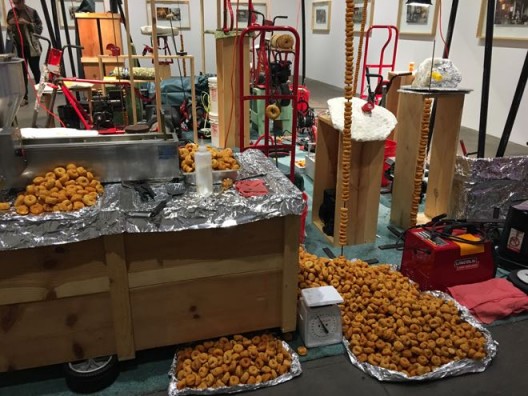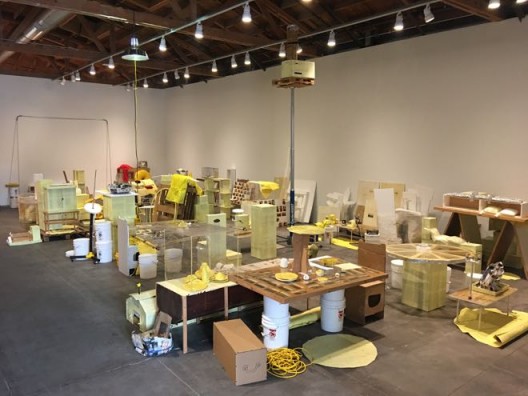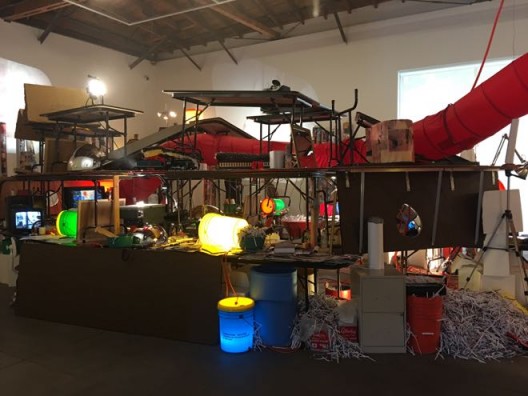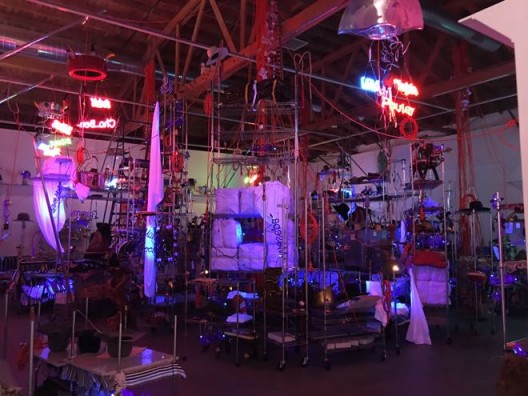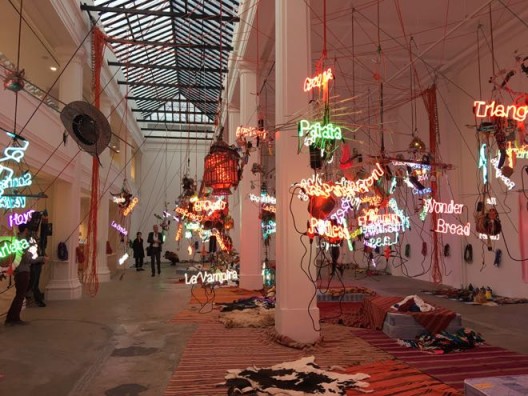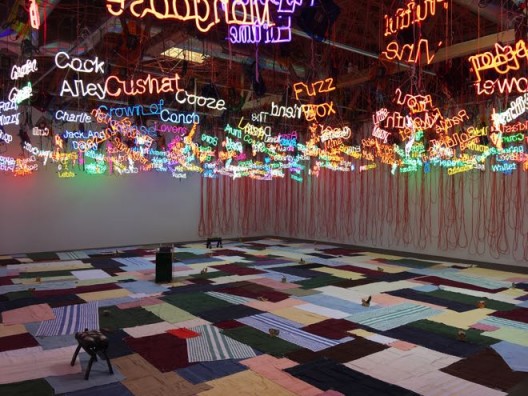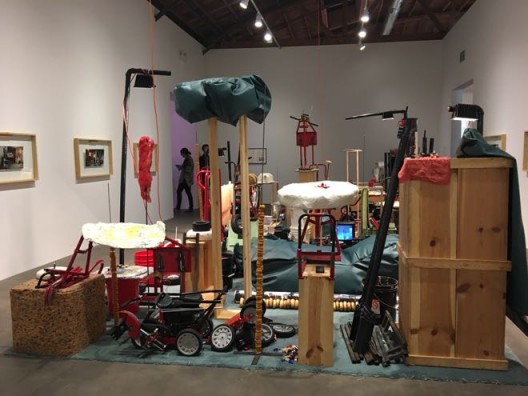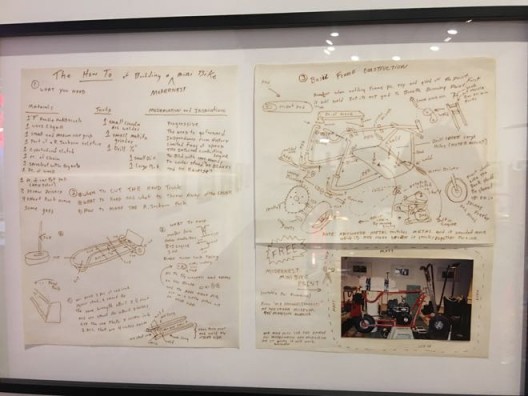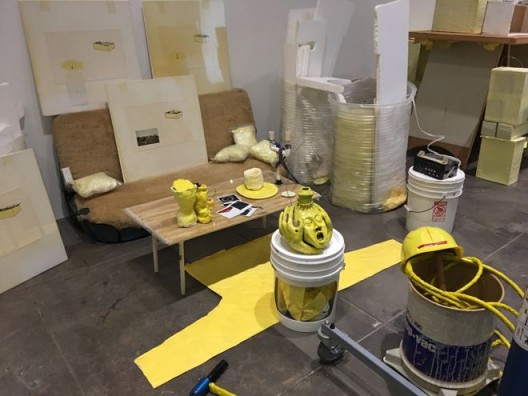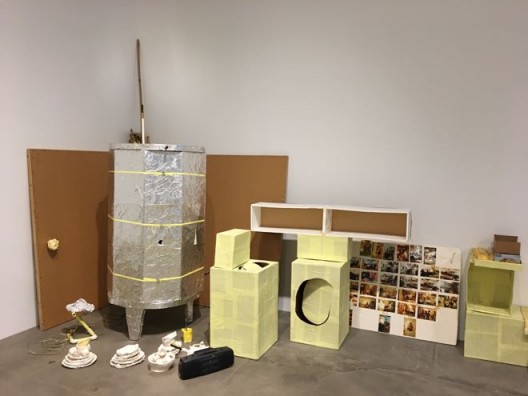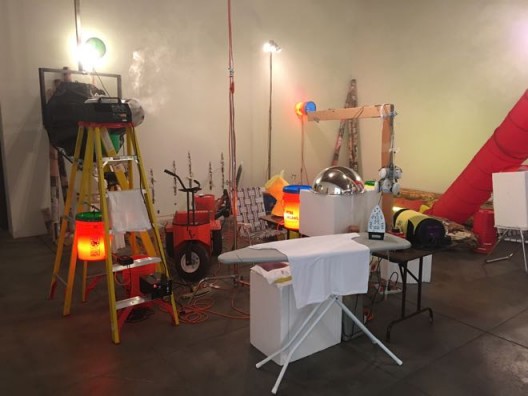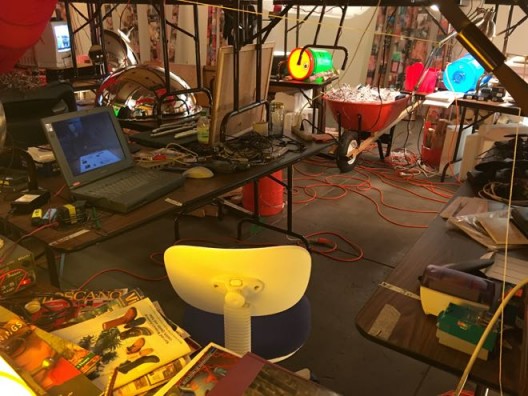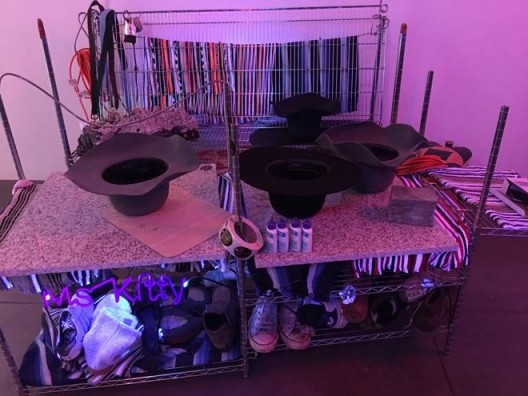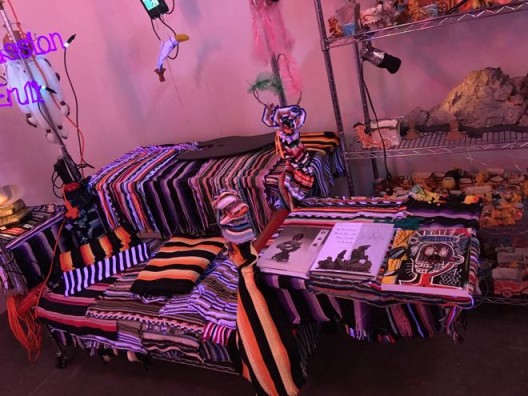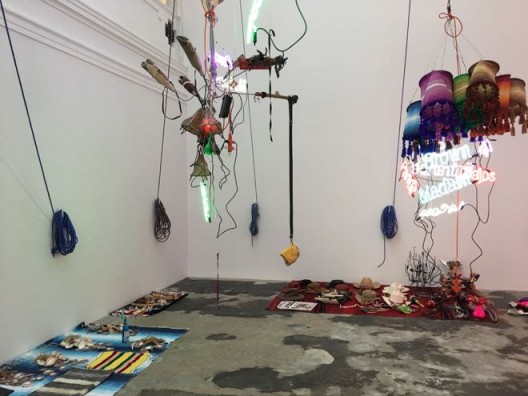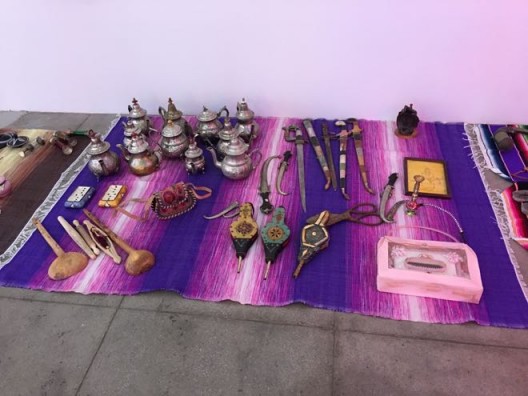Jason Rhoades, “Installations, 1994–2006″
Hauser Wirth & Schimmel (901 East 3rd Street, Los Angeles), Feb 18–May 21, 2017
Step into a packrat’s lair, and you see wall-to-wall clutter choking up the space. Hoarding can be such a compulsive psychological disorder that it debilitates a person’s social functioning and sense of reality. One might wonder the same about Jason Rhoades (1965–2006), a California native and student of Paul McCarthy, who in his short life created sensational installations, room-size agglomerations of consumer goods often decked out with his notorious neon pussy signs that spell out words for female genitalia in multiple languages. After his parting from Rosamund Felsen Gallery in the early 1990s, Rhoades has not been given a solo presentation in Los Angeles, his home city, until now. Six such labyrinthine works are on view for a condensed survey at Hauser & Wirth & Schimmel Los Angeles that sprawls over six floors—perched on scaffolding, hung from ceilings, and dangling in the air.
Twisting and turning among the paths and zooming in on intricate details, viewers quickly lose their bearings in the attempt to navigate the density of visual data. If Rhoades’s mazes are overwhelming to view, then imagine the task of setting them up in Rhoades’s absence. Such is the task left to Rick Baker, Rhoades’s studio manager for the last four years of the artist’s life. To resurrect the mammoth installations, Baker must follow strictly predetermined procedures first meticulously laid out by the artist in order to codify the works’ internal logic and then recorded with diagrams, photographs, notes, and videos. These archives constitute the reference points and protocols for construction, dismantlement, and preservation. Rhoades claimed that the process itself is as crucial as the spectacular end result.
“Swedish Erotica and Fiero Parts” (1994), a yellow sea of mundane objects made up of cheap materials—cardboard boxes, Styrofoam, notepads, and various scraps—was an early work by the artist after graduating from university (UCLA). The entire installation comprises twenty units seamlessly put together in clusters, with the layout resembling an IKEA floor plan, as though it were a psychological weapon aimed at disarming the consumer’s autonomy and maximizing impulse purchases by imposing a predetermined shopping route. And if there is a mistake during the installation? Baker let out a big sigh, “You can’t tweak it or backpedal. You have to take down everything and start all over again. The process was meant by Jason to be a consistent flow without interruption.”
The room behind the yellow maze hosts the massive “Creation Myth” (1998), an overloaded, anecdotal, and hypersexual anthropomorphic mess that evokes the processes of the brain and the digesting system of a heterosexual man. A network of stacked tables forms the brain. Electronic gadgets, toys, mechanical tools, chopped wood, shredded paper and pornographic clips are scattered about, calling to mind a madman’s unkempt garage. As if this were not chaotic enough, Rhoades adds a live video feed, flashing computer screens, and throbbing sounds to the distraction. A long tube connects the brain to the excretory system on the other end of the room, where a machine erupts smoke rings like farts, and piles of leftover or “excrement” are marked by a brightly lit bucket with a label stating “17. THE SHIT.” Pay attention, and you will discover in the bewildering disarray many brightly lit buckets with labeled numbers and scripts outlining the implicit order for viewing.
Similarly, Rhoades’ legendary “The Black Pussy…and the Pagan Idol Workshop” (2005) is another over-the-top sculptural installation that incorporates a few dozen commercial kitchen shelves, cheek by jowl. Each shelf is filled with dream-catchers, hookah pipes, beaver-felt cowboy hats, and other random paraphernalia stacked up high on top of one another and littered with ultraviolet pussy neon signs. This phantasmagoric work is reminiscent of a packed bazaar, suffocating enough to give the viewer—who shuffles elbow to elbow through crannies in the entanglement—an anxiety attack. “Did you have nightmares when you installed it?” I asked. “Oh God,” Baker covered his face with his palms. He woke up three, four times every night during the installation worrying that he might have missed something.
A bad boy who lived a restless and reckless life, Jason Rhoades still occupies a larger-than-life place in the art world despite dying of a drug-induced heart attack in 2006, shortly after the completion of his orgiastic “Tijuanatanjierchandelier” (2006). The work, yet another mind-boggling room installed at the gallery, is full of nonsensical souvenirs purchased on his shopping trips to Tijuana and Tangier, as well as dazzling chandeliers made from his infamous pussy neon signs. Rhoades’s gift was his understanding of space as a medium that confronts the viewer with a visceral impact. The younger generation of artists, such as Jon Rafman, Parker Ito, and Ed Fornieles (to name a few) arguably inherited his spatial re-imagination in a different guise (while Rhoades himself was first embraced in Europe, in company with Dieter Roth, Thomas Hirschhorn, John Bock, and Jonathan Meese). However, in spite of the gallery’s effort to spin his oeuvre as politically charged and relevant in the present moment of heightened political tension, his fantastical installations present the illusory detritus of a consumerist society. It seems to me that Rhoades neither complained about soulless banality nor critiqued the material world. His cobweb-like installation bombarded with exotic tchotchkes from Tijuana and Tangier fails to convince as a critical commentary on “border issues or immigration crisis”, as the gallery claims; instead, it argues for a Paul-McCarthy-and-Mike-Kelley–inspired flea-market aesthetic of redemption and the libidinal gratification of scatology.
Rhoades’ outrageous lifestyle and precious little insight into self-care resonate with his symptomatic display of excessive social data and sensory stimuli in his art. His death can be read on one level as an act of radical self-destruction. Hovering over the tragic grandeur of haunting works and the large volume of manuscripts and documents are enigmatic questions: Was his art created and documented to prepare for his death? Or was his death to complete his narrative? Is mortality the logic reconciliation for the clash between his aspiration for the greatness and the reality that he was consumed by his own rampaging testosterone and Dionysian self-indulgence?
[On 24 February, a few days after the above exhibition opened, Hauser & Wirth announced that Paul Schimmel “will no longer serve as Director, Partner, and Vice President of the gallery.” Schimmel joined Hauser & Wirth in May 2013, after having worked as chief curator at LA’s Museum of Contemporary Art (MOCA) since 1990. Ran Dian has asked both the gallery and Mr Schimmel for comment but both demurred.]
Danielle Shang is Ran Dian LA Contributor.


